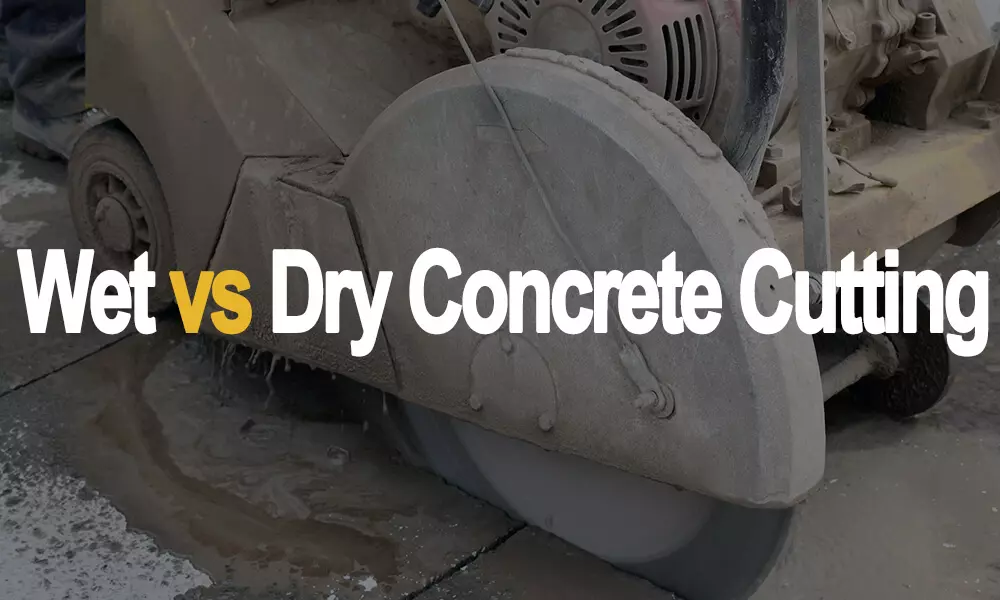In construction and renovation projects, cutting through concrete, asphalt, tiles, or other hard materials is a common requirement. However, choosing the right cutting method—wet or dry—is crucial to achieving the best results while minimizing risks and maximizing efficiency. Each method has its pros and cons, making one method more suitable than the other depending on the project’s specifics, environmental factors, and the equipment available. This article explores both wet and dry cutting techniques to help you decide which approach is best for your project. Whether you’re working with a professional concrete cutting contractor in LaBelle or considering a DIY approach, understanding these cutting methods is essential.
Understanding Wet Cutting
Wet cutting is a method that involves using water to cool down the blade while cutting through tough materials. This technique is commonly used in concrete, asphalt, and masonry cutting, as the water helps to control dust and reduces the blade’s temperature, extending its life. Here’s a deeper dive into the features and benefits of wet cutting.
Key Features of Wet Cutting
Water Flow: Wet cutting tools have a built-in water feed system or can be connected to an external water source to ensure continuous water flow.
Dust Control: Wet cutting significantly reduces dust particles in the air, making it a safer choice for indoor projects.
Blade Longevity: The water cools down the blade, reducing friction and heat, which prevents the blade from wearing out quickly.
Cleaner Cuts: The cooling effect and dust suppression result in smoother and cleaner cuts, making it ideal for precise projects.
Advantages of Wet Cutting
Reduced Dust: Wet cutting helps control silica dust, which is a significant health hazard when cutting materials like concrete. This is essential in environments where air quality control is a priority.
Extended Tool Life: Since water cools the blade, it experiences less wear, meaning that the blade can last longer than it would with dry cutting.
Better Cut Quality: The use of water helps achieve more accurate cuts, which is advantageous for high-precision tasks.
Lower Noise Levels: Wet cutting generally produces less noise, making it suitable for areas with noise restrictions.
Disadvantages of Wet Cutting
Water Requirements: Wet cutting requires a continuous water supply, which can be challenging in locations with limited access to water.
Slippery Conditions: Using water can create a slippery work area, which increases the risk of accidents if proper safety measures aren’t taken.
Additional Cleanup: Wet cutting can produce a slurry mixture that needs to be cleaned up afterward, which can be time-consuming.
Limitations in Cold Weather: In colder climates, water can freeze on the equipment, making wet cutting unsuitable in freezing conditions.
Understanding Dry Cutting
Dry cutting, as the name suggests, does not use water. Instead, it relies on airflow to keep the blade cool while cutting through hard materials. Dry cutting is commonly used for smaller jobs or outdoor projects where dust control is less of a concern. Here’s a closer look at what dry cutting entails.
Key Features of Dry Cutting
No Water Needed: Dry cutting tools do not require a water source, making them more convenient for remote or arid locations.
Air-Cooling System: Most dry-cutting equipment has a special airflow system to keep the blade cool during operation.
Less Cleanup: Since no slurry is produced, there is minimal cleanup required after the job is done.
Portable: Since no water source is required, dry cutting tools are typically lighter and easier to transport.
Advantages of Dry Cutting
Portability: Dry cutting tools are highly portable and do not rely on water, which is ideal for remote job sites.
Faster Setup: Without needing to set up a water source, dry cutting tools allow you to get to work quickly, saving time on smaller jobs.
Less Cleanup: Since dry cutting doesn’t produce slurry, it results in a cleaner work area post-project.
Suitable for Small Jobs: Dry cutting is often preferred for small, quick cuts that don’t require extreme precision.
Disadvantages of Dry Cutting
Higher Dust Production: Without water, dry cutting produces a lot of dust, which can pose a health hazard and make it unsuitable for enclosed spaces.
Blade Wear: Due to the absence of cooling water, the blade can wear out more quickly, especially with prolonged use.
Limited to Certain Materials: Dry cutting is typically not recommended for extremely dense materials like thick concrete, as it can overheat the blade.
Noise Levels: Dry cutting is often louder, which can be an issue in noise-sensitive areas or neighborhoods.
Factors to Consider When Choosing Between Wet and Dry Cutting
Selecting the right cutting method isn’t always straightforward. Here are the main factors to consider to ensure you choose the most effective approach for your project.
Type of Material
Concrete and Masonry: Wet cutting is often better for harder materials like concrete and masonry, as it reduces dust and keeps the blade cool.
Tile and Asphalt: Both wet and dry cutting methods can work with tiles and asphalt, depending on the environment and the scale of the project.
Project Environment
Indoor vs. Outdoor: Wet cutting is safer for indoor projects because it reduces dust, while dry cutting is often reserved for outdoor or well-ventilated areas.
Climate: In cold weather, wet cutting may not be feasible due to the risk of water freezing, making dry cutting a more viable option.
Project Size and Scope
Large-Scale Projects: For larger, precision-heavy projects, wet cutting is often the preferred choice as it minimizes wear on the blade and improves cut quality.
Smaller Jobs: Dry cutting is usually more practical for smaller, quicker jobs where convenience and mobility are prioritized.
Health and Safety Considerations
Dust Control: Since silica dust is hazardous, especially when cutting concrete, wet cutting is often required by OSHA regulations to keep dust levels down.
Noise Pollution: If your project is in a noise-sensitive area, wet cutting’s quieter operation could be beneficial.
Choosing the Right Tools for Each Method
Selecting the right tools is critical, as each method requires specific types of saws and blades to function optimally.
Wet Cutting Tools
Wet Saws: Specialized wet saws have water feed systems to keep the blade cool. These saws are often used by concrete cutting contractors in LaBelle for precise, large-scale cuts.
Diamond Blades: Many wet cutting jobs use diamond blades, which are resilient and perform well in cutting hard materials.
Dry Cutting Tools
Angle Grinders: These tools are often used in dry cutting, particularly for quick, small cuts on thin materials.
Dry Diamond Blades: Designed to withstand high heat, these blades are reinforced for use without water, although they may wear faster than wet-use blades.
Concrete Cutting Contractor Insights
When it comes to larger projects requiring precision, like creating expansion joints or cutting through thick slabs, hiring a professional concrete cutting contractor in LaBelle can make all the difference. Professionals are equipped with the latest wet and dry cutting tools, helping to ensure a cleaner, faster, and safer job completion.
Core Drilling Services in LaBelle: Core drilling services often require wet cutting to ensure the accuracy of circular cuts through thick materials, like concrete or asphalt.
Concrete Cutting Services in LaBelle: Professional services can determine the best cutting method based on project specifics, environmental factors, and regulatory requirements, ensuring that the job is done efficiently and safely.
Environmental Impact and Waste Management
An often-overlooked aspect of wet vs. dry cutting is the environmental impact. Here’s a comparison of how each method fares:
Wet Cutting’s Environmental Impact
Water Usage: Wet cutting requires a significant amount of water, which could be a drawback in areas with water restrictions.
Slurry Management: The slurry created during wet cutting must be disposed of properly to prevent environmental contamination.
Dry Cutting’s Environmental Impact
Air Quality: The dust produced can lower air quality, making dry cutting less environmentally friendly if not controlled properly.
Lower Resource Use: Since it doesn’t require water, dry cutting is a more resource-efficient option, albeit with a trade-off in dust production.
Safety Precautions for Wet and Dry Cutting
Both methods carry specific safety risks. Here are some best practices to follow:
Wet Cutting Safety
Protective Gear: Wear waterproof gloves, goggles, and masks to protect against slurry splashes and dust.
Prevent Slipping: Ensure the cutting area is free of trip hazards and consider using anti-slip mats.
Dry Cutting Safety
Respiratory Protection: Due to the high dust levels, a high-quality respirator is essential.
Dust Control: Use a vacuum system or dust collection tool to minimize dust in the work area.
Conclusion: Wet or Dry—Which is Best?
In summary, both wet and dry cutting methods have their place in construction and renovation projects. For high-precision projects that prioritize safety and air quality, wet cutting is often the better choice, particularly for large-scale concrete cutting. However, if you’re working on a small, quick outdoor project, dry cutting may offer greater convenience and portability. Consulting with a professional service, such as a concrete cutting contractor in LaBelle, ensures that the right method is chosen for your specific project needs, maximizing efficiency and safety. Whether you’re in need of core drilling services in LaBelle or general concrete cutting.
Thanks For Visiting at Kinked Press.



